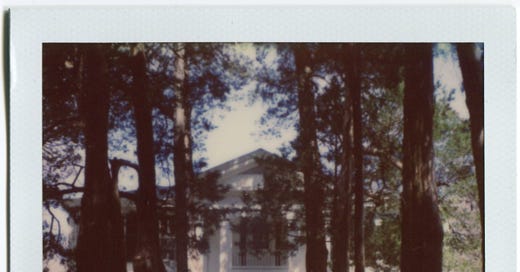I had traveled to Oxford to meet with my editor. It was 2017, and I was tanking my assignment. I wasn’t trying to, but I just couldn’t get it. So she said to come by the place she was working and we could talk it through.
Rowan Oak, Oxford, Mississippi, Polaroid 600 (all photos 2017)
The writer Amanda Malloy was tasked with helping me develop a photo essay on vernacular signs throughout Mississippi. That should have been the easiest thing in the world, since I love hand-lettered signs and celebrating them, but I just couldn’t find the thread.
Amanda had spent a decade working to curate Rowan Oak at that point, ensconced in the home of William Faulkner while writing about the photography of William Eggleston. She suggested I spend time walking around the property and spending time in the house.
Jill’s Room at Rowan Oak, Polaroid 600
I had never been there before, despite a few pilgrimages to the Old Man’s grave over the years. But a grave is a monument to your life once you’re gone; a preserved home like Rowan Oak is a monument to the way you actually lived. Like so many before me, I was startled with the messy blaze of graffitti by the kitchen phone—the number for his nephew Jimmy, scratched out and updated; both the Memphis airport (“White hall 8-3311”) and the Oxford one (2418); several numbers for his daughter Jill over the years. The numbers evolve from 3 digits to 4 depending on how big the town, then to a single prefix plus 4, then area codes and numbers like we have today.
Later a librarian at Ole Miss would help us find the ‘61 Oxford phone book, to see how we would have called him in the year before he died—as close to him as we could have gotten in the timeline—and there he was, legal name and all:1
The librarian also found out what the number was for Rowan Oak when Bill & Estelle moved into it in the early 1930s. Back then it was only three numbers—you would just dial 546.
Kitchen fixture, Rowan Oak, Polaroid SX-70
It was freeing to view Faulkner as a human being who lived in a big old fashioned house and had a rotary phone and was messy and intense. He’s otherwise so easily mysterious and blown up to cartoon size, like Scott Lang in full Giant-Man mode. Walking around that day helped me just calm down and think about the world, and what I loved in it, and stop worrying about trying to document it perfectly. To walk in the woods and be quiet.
Fallen limb, Polaroid SX-70
Amanda eventually created a tribute to her time at Rowan Oak, illustrated by some of my Polaroids, entitled Dial 546. My favorite line of hers was shadowed with regret—that no matter how much you love a place, or a time, or a writer, “you can’t force a ghost to haunt you.”
YESTERDAY was the birthday of the Old Man, and I dug out of my archives a photo made of his really rather lovely gravestone. I never knew him, but I just really don’t think he would have gotten down with the phrase “BELOVE’D / GO WITH GOD.”
I like to think he would have rolled his eyes at that, furrowed his brow at that apostrophe.
Oxford, Mississippi, Polaroid SX-70 (2018)
AS ALWAYS I am gorjusjxn on Instagram, and you can see more Polaroids at McCartyPolaroids. Dial 546 in its original incarnation as a newsprint zine is sold out, but if you would like a PDF, just ring me up.
This address caused me some confusion at first; Rowan Oak is now at 916 Old Taylor Road. The librarian pointed out that MDAH documents show the home was originally listed at that Garfield Street address.








